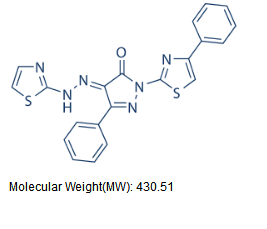All AbMole products are for research use only, cannot be used for human consumption.

In vitro: BTSA1 has no capacity to directly activate the pro-apoptotic homolog BAK. BTSA1 treatment potently and dose-responsively induces membrane translocation of recombinant soluble BAX to mitochondrial membrane, which is followed by induction of BAX oligomerization. BTSA1-induced BAX activation promotes apoptosis in cancer cells. BTSA1 reduces viability of all AML cell lines in a dose-dependent manner with IC50 values ranged between 1 and 4 μM, which leads to complete effect within 24 hr treatment. It induces dose-dependent caspase-3/7 activation in all five AML cell lines.
In vivo: BTSA1 potently suppresses human acute myeloid leukemia (AML) xenografts and increases host survival without toxicity. It is well-tolerated in mice. BTSA1 has no toxic effects on healthy hematopoiesis, including healthy stem cellenriched (LSK) cells, common myeloid progenitors, granulocyte-monocyte progenitors, and megakaryocyte-erythrocyte progenitors. BTSA1 has substantial half-life in mouse plasma (T1/2 = 15 hr) and oral bioavailability (%F = 51), while a 10 mg/kg dose reaches sufficient levels (~15 μM) of BTSA1 to induce BAX activation and apoptosis in leukemia cells. Thus, BTSA1 is orally bioavailable with excellent pharmacokinetics, has significant anti-tumor activity in leukemia xenografts by promoting apoptosis, and at therapeutically effective doses it does not show any detectable toxicity in the hematopoietic system or other tissues.
| Cell Experiment | |
|---|---|
| Cell lines | AML cells |
| Preparation method | AML cells (2 × 10^4 cells/well) are seeded in 96-well white plates and incubated with serial dilutions of BTSA1 or BTSA2 or vehicle (0.15% DMSO) in no FBS media for 2.5 hr, followed by 10% FBS replacement to a final volume of 100 μl. Cell viability is assayed at 24 h |
| Concentrations | |
| Incubation time | 2.5 h |
| Animal Experiment | |
|---|---|
| Animal models | 6-8 weeks old NOD-SCID IL2Rg null (NSG) mice/6-8 weeks old ICR (CD-1) male mice |
| Formulation | 1% DMSO, 30% PEG-400, 65% D5W (5% dextrose in water), 4% Tween-80 |
| Dosages | 10 mg/kg |
| Administration | oral gavage or intravenous injection |
| Molecular Weight | 430.51 |
| Formula | C21H14N6OS2 |
| CAS Number | 314761-14-3 |
| Solubility (25°C) | 81 mg/mL in DMSO |
| Storage |
Powder -20°C 3 years ; 4°C 2 years In solvent -80°C 6 months ; -20°C 1 month |
| Related Bcl-2 Products |
|---|
| ABBV-467
ABBV-467 is a selective MCL-1 inhibitor (Ki: <0.01 nM). |
| WEHI-539
WEHI-539 is a selective inhibitor of Bcl-XL with an IC50 of 1.1 nM. |
| (Rac)-Lisaftoclax
(Rac)-Lisaftoclax ((Rac)-APG-2575) is a Bcl-2 inhibitor that can be uesd for hematologic malignancy research. |
| BcI-2/BcI-xI ligand 1
BcI-2/BcI-xI ligand 1 is a BcI-2/BcI-xI ligand, and can be used for synthesis of PROTAC BcI-2/BcI-xI Degrader-1. |
| AZD-5991 (S-enantiomer)
AZD-5991 S-enantiomer is the less active enantiomer of AZD-5991. |
All AbMole products are for research use only, cannot be used for human consumption or veterinary use. We do not provide products or services to individuals. Please comply with the intended use and do not use AbMole products for any other purpose.


Products are for research use only. Not for human use. We do not sell to patients.
© Copyright 2010-2024 AbMole BioScience. All Rights Reserved.
